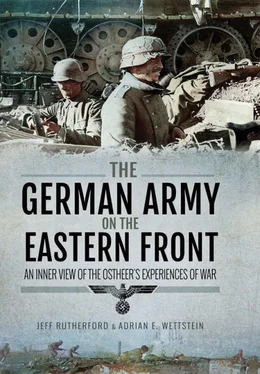3) Deployment of all hereby released German soldiers into the infantry and formation of special branch combat units.
In detail:
A) Disbanding and reduction
1) The disbanding of units and formations (III. battalions […]) must be a complete one and may not be temporary. It is precisely the ‘cadre personnel’ and the baggage trains that yield gains in men.
2) Reduction of batteries to 3 guns. The fourth guns have to be parked division-wise with the least amount of German supervision and Russian support personnel. Cannoneers and drivers who are freed in this way cannot be used for filling open positions in the artillery.
3) Reduction of the baggage trains. Even where this has already been ordered and carried out, it is again necessary to examine with the strictest criteria, which parts a) can be completely disbanded, b) can be stored throughout the winter, thus freeing soldiers for combat use. I expect that commanders of all degrees will take drastic measures here.
4) As soon as the winter position is reached, approximately 50% of all horses and a large part of the motor vehicles are to be stored in the hinterland. For the care of these horses and motor vehicles, only Russian Hilfswillige and only the absolutely necessary supervisory personnel, which at the same time carries out the training of the Hilfswillige (for example as a driver of the horse, a driver, technical staff, etc.) are to be assigned to them.
[…]
5) The reduction and modification of existing tables of organization are in preparation. Correspondingly, we must now proceed. According to these, the following disappeared: about 10% in each battalion and regimental staff, 8 men per battery, all not absolutely necessary motorcycle drivers, messengers, command post clerks and drivers in each engineer battalion, the heavy machine gun group in the cavalry companies of each reconnaissance battalion, some 10% per signal battalion. In the case of supply troops, it is intended to merge all the horse drawn columns and small truck columns into large horse-drawn columns and large motor vehicle columns to save command and crew personnel.
While the order aimed at creating new frontline soldiers, primarily infantry and engineers, it also reveals an often forgotten issue. Losses in combat and rear area troops were not at the same level. In his pioneering study on the 253rd Infantry Division, Christoph Rass has indicated the level in which losses diverged between the rear and front. While many infantry units were virtually destroyed more than once, loss rates in rear area units were rather low, except for extraordinary circumstances (that admittedly became more common beginning in 1944). The difficulty in regulating the recruitment and flow of replacements often led to imbalances between rear services and frontline troops. Orders such as the one mentioned above tried to realize that balance. But there were also limits to the exchange of personnel from the rear area to the front. The last-surviving sons and fathers of several children could not be endangered for morale reasons, while men physically unfit for frontline duty were more ballast than asset. The same was true with older men, but the age limit was continuously raised as the pool of younger men gradually depleted. In addition to the imbalance between rear and frontline troops, the sustaining of cadre units was also a vital issue. While – as mentioned in the order – this led to a real gain in combat power, the issue was more complex than that. Neither rebuilding units from scratch nor integrating completely new units was an easy task, as was demonstrated by the experience of the 5th Panzer Division. The massive dissolution of battalion-level units in 1942 in the traditional divisions and the formation of many new units, such as independent infantry battalions or the already mentioned Luftwaffe Field Divisions, marked the first step in the erosion of the German infantry that would eventually evolve into the infantry crisis. As a result, the German army lost much of its tactical superiority, which had been an essential component of its ability to successfully fight against numerically superior foes.
As part of its internal shifting of troops, Sixth Army also amended some points to the order, thereby sharpening it: [18]
1) In the staff of the Sixth Army (including the army engineer leader and the army signal leader): return of all officers, NCOs, and men commanded to the staff of the 6th Army; reduction of the remaining actual strength by 10-15%; in addition: replacement of additional soldiers by Russian Hilfswillige . […]
2) In the corps and divisional staffs: return of all officers, NCOs, and men commanded to these staffs; reduction of the remaining actual strength by 10%; in addition: replacement of additional soldiers by Russian Hilfswillige . […]
3) Formation of alarm units: all units of the divisions, which are not directly deployed at the front (parts of the signal battalion, supply units, etc.), of all higher staffs (from divisional staff to and including army headquarters), all corps troops and all army troops not immediately fighting at the front.
4) Disbanding of a rifle company in the infantry battalions and of the 3rd battalion in the infantry regiments, for the saving of baggage trains, etc., in cases where the combat strengths are not in a sustainable relationship with the baggage trains’ strength.
5) Reduction of soldiers and units not directly engaged in combat in the divisions and likewise in the army troops:
Reduction of battalion and regimental staffs by about 10%
Reduction of batteries to 3 guns (removal of the 4th cannon for overhaul and as a material reserve)
Disbanding of individual batteries. Formation of 6-gun batteries […]
6) Handover of 2 NCOs and 10 men from each bridging column to the engineer battalions. […]
8) c) Registration of soldiers not suitable for infantry service, as well as of the last surviving sons from the divisions’ units and all soldiers from the army troops in divisional replacement battalions and army troop replacement battalions (directly subordinated to the Sixth Army).
Training of these replacement battalions for infantry defensive warfare in winter. Deployment is intended only in crisis situations, disbanding and return of the soldiers to their original units in the spring or after receiving sufficient replacements is intended. Use of the army troops replacement battalions only by order of the army command. Beginning of training in the replacement battalions from 5.11.42.
In addition to the measures ordered by the OKH, Sixth Army ordered the disbanding of further units on the lower levels, the reduction of staffs, including higher levels, and decreed that the corps and army levels free soldiers too. Sixth Army at this time was – as seen in chapters 1and 4 – in an extremely difficult situation in and around Stalingrad and in need of every fighting man for the front.
A further means to gain frontline soldiers was to replace German soldiers in various positions by so-called Hilfswillige (literally: one willing to help), Russian men generally drafted into the Wehrmacht for auxiliary services, though in a few cases, they were also used in combat. To be clear: the Hilfswillige formed just one group of Soviet collaborators, but they were the most numerically important for the German army in the east, with their numbers estimated between 800,000 and one million. Divisional files reveal that many divisions employed between 700 and 1,500 Hilfswillige in their ranks in 1942 and 1943. While the initial use of Soviet prisoners of war – the primary source for Hilfswillige – was improvised, the German military in its typical manner developed a set of regulations concerning Hilfswillige in 1942 and 1943, including rations, payment, uniforms, insignia and so on. The training for these men aimed mainly at moulding them into convinced anti-communists and thereby reliable auxiliaries. This was directly formulated in the following manual: [19]
Читать дальше






![John Stieber - Against the Odds - Survival on the Russian Front 1944-1945 [2nd Edition]](/books/405234/john-stieber-against-the-odds-survival-on-the-russian-front-1944-1945-2nd-edition-thumb.webp)





